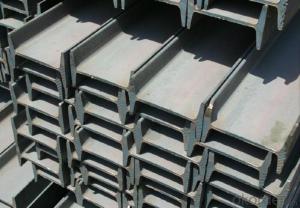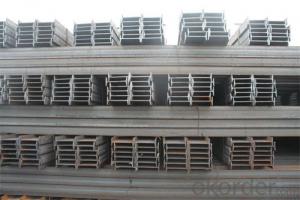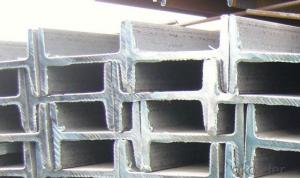Hot Rolled Steel of Q235B IPEAA80 for Construction Steel I-Beams
- Loading Port:
- Tianjin
- Payment Terms:
- TT or LC
- Min Order Qty:
- 25 m.t.
- Supply Capability:
- 100000 m.t./month
OKorder Service Pledge
OKorder Financial Service
You Might Also Like
OKorder is offering high quality Hot Rolled Steel I-Beams at great prices with worldwide shipping. Our supplier is a world-class manufacturer of steel, with our products utilized the world over. OKorder annually supplies products to European, North American and Asian markets. We provide quotations within 24 hours of receiving an inquiry and guarantee competitive prices.
Product Applications:
1. Supporting members, most commonly in the house raising industry to strengthen timber bears under houses. Transmission line towers, etc
2. Prefabricated structure
3. Medium scale bridges
4. It is widely used in various building structures and engineering structures such as roof beams, bridges, transmission towers, hoisting machinery and transport machinery, ships, industrial furnaces, reaction tower, container frame and warehouse etc.
Product Advantages:
OKorder's Steel I-Beams are durable, strong, and resist corrosion.
OKorder is offering high quality Hot Rolled Steel I-Beams at great prices with worldwide shipping. Our supplier is a world-class manufacturer of steel, with our products utilized the world over. OKorder annually supplies products to European, North American and Asian markets. We provide quotations within 24 hours of receiving an inquiry and guarantee competitive prices.
Product Applications:
1. Supporting members, most commonly in the house raising industry to strengthen timber bears under houses. Transmission line towers, etc
2. Prefabricated structure
3. Medium scale bridges
4. It is widely used in various building structures and engineering structures such as roof beams, bridges, transmission towers, hoisting machinery and transport machinery, ships, industrial furnaces, reaction tower, container frame and warehouse etc.
OKorder is offering high quality Hot Rolled Steel I-Beams at great prices with worldwide shipping. Our supplier is a world-class manufacturer of steel, with our products utilized the world over. OKorder annually supplies products to European, North American and Asian markets. We provide quotations within 24 hours of receiving an inquiry and guarantee competitive prices.
Product Applications:
1. Supporting members, most commonly in the house raising industry to strengthen timber bears under houses. Transmission line towers, etc
2. Prefabricated structure
3. Medium scale bridges
4. It is widely used in various building structures and engineering structures such as roof beams, bridges, transmission towers, hoisting machinery and transport machinery, ships, industrial furnaces, reaction tower, container frame and warehouse etc.
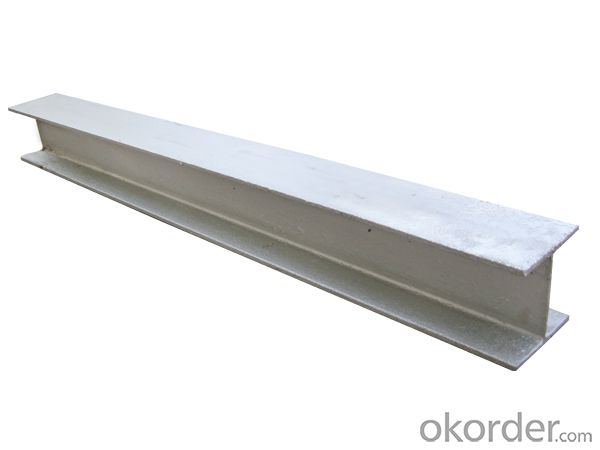
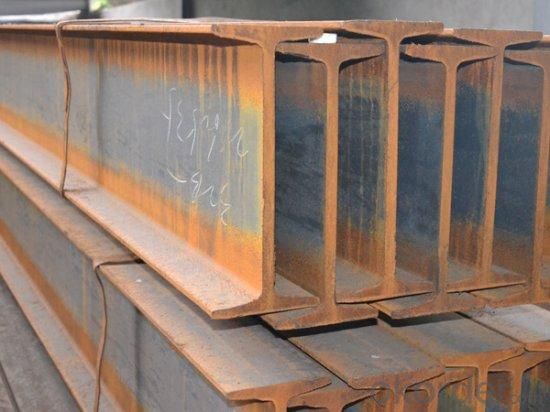
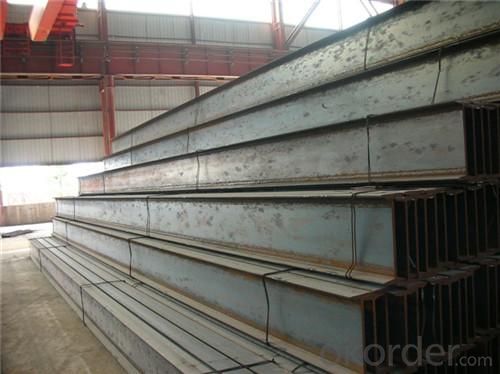
- Q:Can steel I-beams be used for helipad construction?
- Indeed, helipad construction can utilize steel I-beams. When it comes to constructing helipads, steel I-beams are widely chosen and well-liked due to their robustness, endurance, and capacity to bear substantial loads. The structural configuration of I-beams enables them to evenly distribute weight along their length, making them ideal for supporting helicopters during takeoff, landing, and parking. Furthermore, steel I-beams can withstand a variety of weather conditions, such as strong winds and heavy rain, ensuring the stability and durability of the helipad. In conclusion, steel I-beams offer a dependable and effective solution for constructing helipads.
- Q:How do steel I-beams perform in areas with high UV exposure?
- Steel I-beams perform well in areas with high UV exposure. The high carbon content in the steel helps to increase its resistance to UV radiation, preventing it from degrading or weakening over time. Additionally, steel can be coated with protective finishes or painted to further enhance its durability against UV exposure.
- Q:How are Steel I-Beams protected during construction?
- To guarantee the structural integrity and durability of steel I-beams during construction, various methods are employed. One primary technique involves the use of protective coatings and paints, which serve as a barrier between the steel and external factors like moisture, chemicals, and atmospheric conditions. These coatings are vital in providing resistance against corrosion and preventing rust formation, which is crucial for preserving the strength and longevity of the I-beams. Furthermore, during the construction process, it is common to cover or wrap steel I-beams with temporary materials such as plastic sheets or tarps. This precautionary measure shields the beams from direct exposure to rain, snow, or excessive sunlight, all of which can hasten corrosion and weaken the beams over time. Moreover, I-beams are typically stored in a dry and controlled environment to prevent moisture absorption and minimize the risk of corrosion. Additionally, they may be lifted or placed on wooden or rubber mats to avoid direct contact with the ground, thereby reducing the potential damage or corrosion caused by moisture or chemicals present in the soil. In certain cases, galvanization is employed for steel I-beams. This process entails applying a layer of zinc to the beams, creating a robust protective barrier against rust and corrosion. Galvanization is commonly utilized in outdoor structures like bridges, where the beams are exposed to harsh environmental conditions. Regular inspection and maintenance play a vital role in safeguarding steel I-beams during construction. Any indications of damage, corrosion, or wear should be promptly addressed and repaired to ensure the beams' structural integrity and safety. In conclusion, the protection of steel I-beams during construction involves the application of protective coatings, temporary coverings, controlled storage, and regular maintenance. These measures are essential to prevent corrosion, maintain strength, and extend the lifespan of the beams, ultimately guaranteeing the safety and stability of the construction project.
- Q:Are there any alternatives to steel I-beams for structural support in construction?
- Yes, there are numerous options for structural support in construction instead of steel I-beams. One possibility is to utilize reinforced concrete beams, which involve embedding steel rebar within the concrete. This combination allows for both the compressive strength of concrete and the tensile strength of steel, resulting in highly durable beams capable of withstanding heavy loads. Another option is the use of laminated timber beams, also known as glulam beams. These beams are created by bonding multiple layers of timber together using adhesives. As a result, they are not only strong and lightweight but also aesthetically pleasing. Glulam beams offer a sustainable alternative to steel since they are made from renewable resources and have a lower carbon footprint. In addition, engineered wood products like laminated veneer lumber (LVL) and parallel strand lumber (PSL) can serve as alternatives to steel I-beams. LVL is manufactured by layering thin wood veneers and bonding them together, creating a robust and dimensionally stable beam. PSL, on the other hand, is produced by aligning and bonding wood strands, resulting in a beam with high strength and stiffness. Fiber-reinforced polymers (FRP) are also emerging as an alternative to steel I-beams. FRP composites consist of fibers embedded in a polymer matrix, such as carbon fiber reinforced polymer (CFRP) or glass fiber reinforced polymer (GFRP). These materials offer excellent strength-to-weight ratios, corrosion resistance, and durability. However, they are still undergoing research and development for widespread use in construction. In conclusion, despite the common utilization of steel I-beams for structural support in construction, there are several viable alternatives available, including reinforced concrete beams, laminated timber beams, engineered wood products, and fiber-reinforced polymers. The choice of an alternative will depend on various factors such as load requirements, design preferences, sustainability objectives, and cost considerations.
- Q:How do steel I-beams contribute to the overall sustainability of a building?
- Steel I-beams contribute to the overall sustainability of a building in several ways. Firstly, steel is a highly durable and long-lasting material, which means that I-beams made from steel can withstand heavy loads and provide structural support for many years. This durability reduces the need for frequent repairs or replacements, thus minimizing waste and conserving resources. Moreover, steel is a recyclable material, meaning that I-beams can be manufactured using recycled steel or can be recycled themselves at the end of their lifespan. This recycling process significantly reduces the environmental impact of steel production and helps to conserve natural resources. Additionally, the energy required to recycle steel is considerably less than that needed to produce it from scratch, further contributing to sustainability efforts. Furthermore, steel I-beams have a high strength-to-weight ratio, which means that they can support significant loads while using a relatively smaller amount of material compared to other alternatives. This efficiency in material usage reduces the overall carbon footprint of a building, as less steel is required for the construction of the structure. Another aspect of sustainability that steel I-beams contribute to is the ability to create open and flexible floor plans. The use of I-beams allows for longer spans and wider spaces, minimizing the need for additional columns or supports. This design flexibility allows for adaptable and customizable spaces, which can accommodate changing needs over time, ultimately extending the lifespan of a building and reducing the potential for demolition and waste. In conclusion, steel I-beams contribute to the overall sustainability of a building through their durability, recyclability, efficient material usage, and design flexibility. By choosing steel I-beams, architects and builders can help create environmentally-friendly structures that conserve resources, reduce waste, and have a longer lifespan.
- Q:Can steel I-beams be used for military structures?
- Yes, steel I-beams can be used for military structures. They are commonly used in the construction of military buildings, hangars, bridges, bunkers, and other infrastructure due to their strength, durability, and load-bearing capabilities.
- Q:How do steel I-beams contribute to sustainable construction certifications?
- There are several ways in which sustainable construction certifications benefit from the presence of steel I-beams. To begin with, steel is a material known for its durability and long-lasting nature. Steel I-beams possess a high strength-to-weight ratio, enabling them to support heavy loads while using less material than alternative options. By utilizing materials more efficiently, waste is reduced and the environmental impact of construction projects is minimized. In addition, steel is a recyclable material. At the end of their life cycle, steel I-beams can be easily recycled, eliminating the need for new raw materials and reducing the carbon footprint associated with steel production. The act of recycling steel also helps conserve energy and decrease greenhouse gas emissions. Moreover, steel I-beams contribute to energy efficiency in buildings. Their presence allows for the creation of open floor plans and large window openings, enabling natural daylight to enter and decreasing reliance on artificial lighting. Furthermore, when integrated with insulation materials, steel I-beams enhance the thermal performance of the building envelope, leading to reduced energy consumption for heating and cooling purposes. From a sustainable design perspective, steel I-beams offer flexibility and versatility. They can be customized and adapted to various architectural designs, promoting efficient use of space and maximizing the functionality of the building. This adaptability also contributes to the longevity of the structure, as modifications or expansions can be easily carried out in the future, eliminating the need for demolition and reconstruction. Lastly, steel I-beams are often manufactured using advanced technologies and processes that prioritize energy efficiency and waste minimization. Many steel manufacturers have incorporated sustainable practices into their operations, such as utilizing recycled materials, optimizing production processes, and reducing emissions. These sustainable manufacturing practices align with the requirements of sustainable construction certifications, promoting overall environmental responsibility. In summary, the presence of steel I-beams in construction contributes to sustainable certifications through their durability, recyclability, energy efficiency, design versatility, and sustainable manufacturing practices.
- Q:Can Steel I-Beams be used for gymnasiums or sports facilities?
- Yes, Steel I-Beams can be used for gymnasiums or sports facilities. They are commonly used in these types of structures due to their strength, durability, and ability to support heavy loads. Steel I-Beams provide the necessary structural support for large spans and open spaces required in gymnasiums and sports facilities.
- Q:How do steel I-beams handle differential settlement in the foundation?
- Due to their strength and durability, steel I-beams are widely utilized in construction. They are a favored choice when it comes to managing differential settlement in the foundation. Differential settlement refers to the uneven sinking or shifting of a building's foundation. This occurs when the soil beneath the foundation settles at varying rates, causing one section of the building to sink or shift more than another. Steel I-beams are specifically engineered to evenly distribute the load across the foundation, which helps to alleviate the effects of differential settlement. The I-beam's structure, consisting of flanges and a web, creates a robust and rigid framework capable of effectively handling differential settlement. One way in which steel I-beams address differential settlement is by providing a level and stable support system for the building. These beams are strategically positioned to bear the weight of the structure and transfer it to the foundation, minimizing the impact of any settlement. The strength and stiffness of steel enable the I-beams to maintain their shape and resist bending or deflection, even in the presence of differential settlement. Furthermore, steel I-beams are often combined with other foundation support systems, such as pilings or helical piers, to reinforce the foundation and further mitigate the effects of differential settlement. These support systems can be installed at different depths and locations to counteract the varying settlement rates of the soil. In conclusion, steel I-beams are ideal for managing differential settlement in foundations due to their strength, rigidity, and ability to evenly distribute loads. When properly designed and implemented, they provide a reliable and stable support system for buildings, minimizing the impact of settlement and ensuring long-term structural integrity.
- Q:Can steel I-beams be used for renewable energy projects?
- Yes, steel I-beams can be used for renewable energy projects. These beams are commonly used in the construction of various renewable energy structures such as wind turbines, solar panel installations, and hydroelectric power plants. They provide structural support and stability to these projects, ensuring their longevity and efficiency.
1. Manufacturer Overview |
|
|---|---|
| Location | |
| Year Established | |
| Annual Output Value | |
| Main Markets | |
| Company Certifications | |
2. Manufacturer Certificates |
|
|---|---|
| a) Certification Name | |
| Range | |
| Reference | |
| Validity Period | |
3. Manufacturer Capability |
|
|---|---|
| a)Trade Capacity | |
| Nearest Port | |
| Export Percentage | |
| No.of Employees in Trade Department | |
| Language Spoken: | |
| b)Factory Information | |
| Factory Size: | |
| No. of Production Lines | |
| Contract Manufacturing | |
| Product Price Range | |
Send your message to us
Hot Rolled Steel of Q235B IPEAA80 for Construction Steel I-Beams
- Loading Port:
- Tianjin
- Payment Terms:
- TT or LC
- Min Order Qty:
- 25 m.t.
- Supply Capability:
- 100000 m.t./month
OKorder Service Pledge
OKorder Financial Service
Similar products
New products
Hot products
Hot Searches
Related keywords

